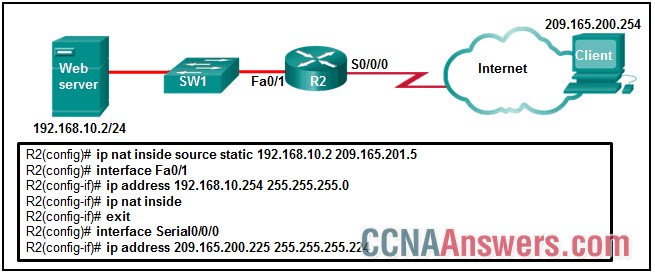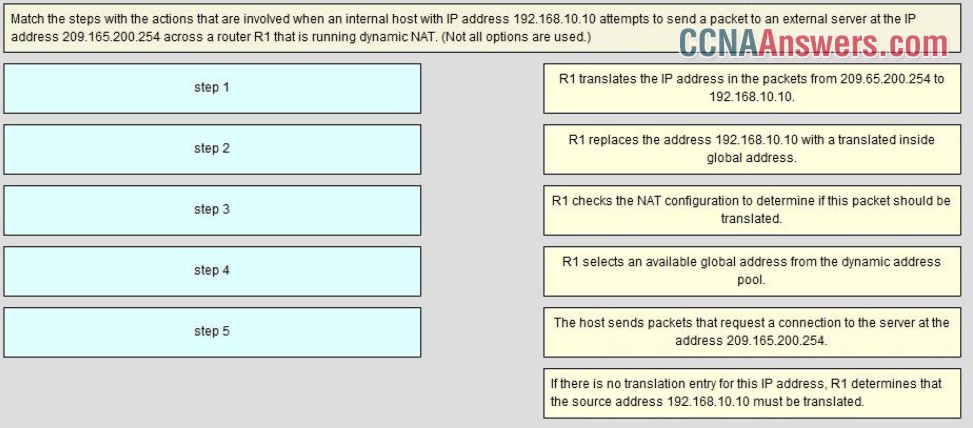CCNA 2 Chapter 9 V6.0 Answers
1. What is a disadvantage of NAT?
The internal hosts have to use a single public IPv4 address for external communication.
There is no end-to-end addressing.
The router does not need to alter the checksum of the IPv4 packets.
The costs of readdressing hosts can be significant for a publicly addressed network.
2. Which statement describes IPv6 ULAs?
They begin with the fe80::/10 prefix.
They are assigned by an ISP.
They are not routable across the internet.
They conserve IPv6 address space.
3. Refer to the exhibit. A technician is configuring R2 for static NAT to allow the client to access the web server. What is a possible reason that the client PC cannot access the web server?

Interface Fa0/1 should be identified as the outside NAT interface.
The configuration is missing a valid access control list.
The IP NAT statement is incorrect.
Interface S0/0/0 should be identified as the outside NAT interface.
4. What is an advantage of deploying IPv4 NAT technology for internal hosts in an organization?
enables the easy deployment of applications that require end-to-end traceability
provides flexibility in designing the IPv4 addressing scheme
makes internal network access easy for outside hosts using UDP
increases the performance of packet transmission to the Internet
5. What are two benefits of NAT? (Choose two.)
It adds a degree of privacy and security to a network.
It makes tunneling with IPsec less complicated.
It makes troubleshooting routing issues easier.
It saves public IP addresses.
It increases routing performance. It makes troubleshooting routing issues easier.
6. A network administrator configures the border router with the command
R1(config)# ip nat inside source list 4 pool corp
What is required to be configured in order for this particular command to be functional?
a NAT pool named corp that defines the starting and ending public IP addresses
an access list numbered 4 that defines the starting and ending public IP addresses
ip nat outside to be enabled on the interface that connects to the LAN affected by the NAT
a VLAN named corp to be enabled and active and routed by R1
an access list named corp that defines the private addresses that are affected by NAT
7. What are two of the required steps to configure PAT? (Choose two.)
Define the range of source ports to be used.
Define the hello and interval timers to match the adjacent neighbor router.
Create a standard access list to define applications that should be translated.
Define a pool of global addresses to be used for overload translation.
Identify the inside interface.
8. What is the major benefit of using NAT with Port Address Translation?
It allows many internal hosts to share the same public IPv4 address.
It improves network performance for real-time protocols.
It provides a pool of public addresses that can be assigned to internal hosts.
It allows external hosts access to internal servers.
9. A network engineer has configured a router with the command ip nat inside source list 4 pool corp overload. Why did the engineer use the overload option?
The company router must throttle or buffer traffic because the processing power of the router is not enough to handle the normal load of external-bound Internet traffic.
The company has a small number of servers that should be accessible by clients from the Internet.
The company needs to have more public IP addresses available to be used on the Internet.
The company has more private IP addresses than available public IP addresses.
10. Match the steps with the actions that are involved when an internal host with IP address 192.168.10.10 attempts to send a packet to and external server at the IP address 209.165.200.254 across a router R1 that running dynamic NAT. (Not all options are used.)

Place the options in the following order:
step 5 => R1 replaces the address 192.168.10.10 with a translated inside global address.
step 2 => R1 checks the NAT configuration to determine if this packet should be translated.
step 4 => R1 selects an available global address from the dynamic address pool.
step 1 => The cost sends packets that request a connection to the server at the address 209.165.200.254
step 3 => If there is no translation entry for this IP address, R1 determines that the source address 192.168.10.10 must be translated.
11. A network administrator is configuring a static NAT on the border router for a web server located in the DMZ network. The web server is configured to listen on TCP port 8080. The web server is paired with the internal IP address of 192.168.5.25 and the external IP address of 209.165.200.230. For easy access by hosts on the Internet, external users do not need to specify the port when visiting the web server. Which command will configure the static NAT?
R1(config)# ip nat inside source static tcp 192.168.5.25 80 209.165.200.230 8080
R1(config)# ip nat inside source static tcp 209.165.200.230 8080 192.168.5.25 80
R1(config)# ip nat inside source static tcp 209.165.200.230 80 192.168.5.25 8080
R1(config)# ip nat inside source static tcp 192.168.5.25 8080 209.165.200.230 80
12. Refer to the exhibit. What is the purpose of the command marked with an arrow shown in the partial configuration output of a Cisco broadband router?
defines which addresses are allowed out of the router
defines which addresses are allowed into the router
defines which addresses can be translated
defines which addresses are assigned to a NAT pool
13. When dynamic NAT without overloading is being used, what happens if seven users attempt to access a public server on the Internet when only six addresses are available in the NAT pool?
All users can access the server.
No users can access the server.
The request to the server for the seventh user fails.
The first user gets disconnected when the seventh user makes the request.
14. Which method is used by a PAT-enabled router to send incoming packets to the correct inside hosts?
It uses the source IP address on the incoming packet.
It uses the destination TCP or UDP port number on the incoming packet.
It uses the source TCP or UDP port number on the incoming packet.
It uses a combination of the source TCP or UDP port number and the destination IP address on the incoming packet.
15. Refer to the exhibit. Based on the output that is shown, what type of NAT has been implemented?

PAT using an external interface
static NAT with a NAT pool
static NAT with one entry
dynamic NAT with a pool of two public IP addresses
16. What is the purpose of port forwarding?
Port forwarding allows for translating inside local IP addresses to outside local addresses.
Port forwarding allows an external user to reach a service on a private IPv4 address that is located inside a LAN.
Port forwarding allows users to reach servers on the Internet that are not using standard port numbers.
Port forwarding allows an internal user to reach a service on a public IPv4 address that is located outside a LAN.
17. Fill in the blank. Do not use abbreviations.
NAT overload is also known as Port Address Translation
18. What is a characteristic of unique local addresses?
They are defined in RFC 3927.
Their implementation depends on ISPs providing the service.
They allow sites to be combined without creating any address conflicts.
They are designed to improve the security of IPv6 networks.
19. What is the primary purpose of NAT?
enhance network performance
allow peer-to-peer file sharing
conserve IPv4 addresses
increase network security
20. Refer to the exhibit. Which address or addresses represent the inside global address?

192.168.0.100
209.165.20.25
any address in the 10.1.1.0 network
10.1.1.2
21. What is defined by the ip nat pool command when configuring dynamic NAT?
the range of external IP addresses that internal hosts are permitted to access
the pool of available NAT servers
the range of internal IP addresses that are translated
the pool of global address


Leave a Reply